
Selly Oak is an industrial and residential area in south-west Birmingham, England. The area gives its name to Selly Oak ward and includes the neighbourhoods of: Bournbrook, Selly Park, and Ten Acres. The adjoining wards of Edgbaston and Harborne are to the north of the Bourn Brook, which was the former county boundary, and to the south are Weoley, and Bournville. A district committee serves the four wards of Selly Oak, Billesley, Bournville and Brandwood. The same wards form the Birmingham Selly Oak constituency, represented since 2024 by Alistair Carns (Labour). Selly Oak is connected to Birmingham by the Pershore Road (A441) and the Bristol Road (A38). The Worcester and Birmingham Canal and the Birmingham Cross-City Railway Line run across the Local District Centre.

Stirchley is a suburb in south-west Birmingham, England. The name likely refers to a pasture for cattle. The settlement dates back to at least 1658. Prehistoric evidence, Roman roads, and Anglo-Saxon charters contribute to its history. The Worcester and Birmingham Canal and the railways brought industry to the area. Stirchley's development is also linked to industries like screw-making and rubber manufacturing. Originally part of Worcestershire, Stirchley underwent administrative changes in 1911. Residential developments were established alongside the long-standing Victorian terracing which is associated with the suburb.
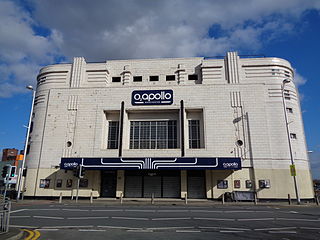
The O2 Apollo Manchester (known locally as The Apollo and formerly Manchester Apollo and ABC Ardwick) is a concert venue in Ardwick Green, Manchester, England. It is a Grade II listed building, with a capacity of 3,500 (2,514 standing, 986 seats).
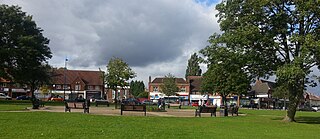
Weoley Castle is a residential suburban district in south-west Birmingham, England. The area is part of the Weoley local authority electoral ward, and also comes under the Northfield local council constituency. The suburb of Weoley Castle is bordered by Selly Oak to the east, Harborne to the north, Bartley Green to the west, and Weoley Hill and Shenley Fields to the south.

Bournbrook is an industrial and residential district in southwest Birmingham, England, in the ward of Bournbrook and Selly Park and the parliamentary constituency of Birmingham Selly Oak. Before 2018 it was in Selly Oak Council Ward. Prior to what is commonly termed the Greater Birmingham Act, which came into effect on 9 November 1911, the Bourn Brook watercourse was the North Eastern boundary of Worcestershire, and the area was locally governed by the King's Norton and Northfield Urban District Council.

Selly Oak railway station is a railway station in Selly Oak in Birmingham, England, on the Cross-City Line between Redditch, Birmingham and Lichfield.
Selly Oak Colleges was a federation of educational facilities which in the 1970s and 1980s was at the forefront of debates about ecumenism - the coming together of Christian churches and the creation of new united churches such as the Church of South India; the relationships between Christianity and other religions, especially Islam and Judaism; child-centred teacher training; and the theology of Christian mission. It was located on a substantial campus in Selly Oak, a suburb in the south-west of Birmingham, England, about a mile from the University of Birmingham. In 2001 the largest college, Westhill College, whose main work was the training of teachers, passed into the hands of the University of Birmingham, and most of the remaining colleges closed, leaving Woodbrooke College, a study and conference centre for the Society of Friends, and Fircroft College, a small adult education college with residential provision, which continue today.
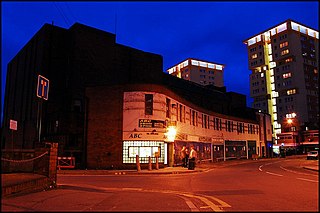
The ABC Cinema was a cinema in Wakefield, West Yorkshire that fell into derelition after its closure. Located in Kirkgate on the corner of Sun Lane, it was designed and built in the Art Deco style for Associated British Cinemas by in-house architect William R. Glen and opened as the Regal Cinema on 9 December 1935.
In its days as an entertainment centre for London, Harringay in North London also provided more locally directed entertainment in the shape of four cinemas. The earliest was opened in 1910 and was operating as a cinema until January 2003.
The Regal Theatre, formerly known as the Chelsea Cinema, the Princess Theatre and the Ozone Marryatville or Marryatville Ozone Theatre, is a single-screen cinema in Kensington Park, a suburb of Adelaide, South Australia. Originally built in 1925 to the designs of South Australian theatre architect Christopher Arthur Smith, it retains the features of a major renovation in Art Deco style in 1941 designed by noted cinema architect F. Kenneth Milne. It was heritage-listed on the South Australian Heritage Register in 1983. It is the oldest continuously running purpose-built cinema in Adelaide, and the only remaining silent cinema still operating in the city. It is owned by Burnside Council.
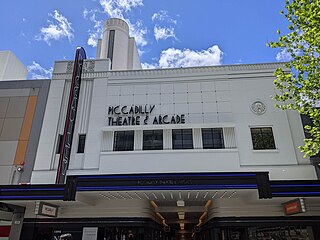
The Piccadilly Cinema Centre and Piccadilly Arcade are located at 700-704 Hay Street, Perth, Western Australia. It is an art deco style cinema and shopping arcade, designed by architect William T. Leighton for mining entrepreneur Claude de Bernales. The theatre and arcade opened in 1938, with the arcade connecting Hay Street through to Murray Street.

Luna Leederville is a cinema complex located at the corner of Oxford and Vincent Streets in Leederville, a suburb of Perth, Western Australia.

John Stanley Coombe Beard FRIBA, known professionally as J. Stanley Beard, was an English architect known for designing many cinemas in and around London.
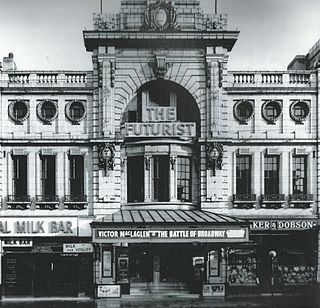
The Futurist Cinema was a cinema located in Lime Street, Liverpool. Opened as Lime Street Picture House in 1912, the cinema operated until closing in 1982. Unable to find a new owner it was left to decline. It was demolished in 2016 after a court battle over the controversial plans for redevelopment of the area.

The Varsity Theatre is a historic movie theater in Martin, Tennessee, USA. The building is listed on the National Register of Historic Places.

The Deco is a restored 1930s cinema and theatre located in the heart of Northampton, England. It is now operated as a venue for corporate, social and theatrical events.

The Odyssey Cinema is a film theatre in the city of St Albans, Hertfordshire, in the United Kingdom. It is a locally listed Art Deco building, located on London Road, around 0.7 kilometres (0.43 mi) east of St Albans Cathedral. Originally built in 1931 as the Capitol Cinema, the current building stands on the site of an earlier film theatre, the Alpha Picture Palace. This former cinema was of particular historical significance as it was opened in 1904 by the film-making pioneer Arthur Melbourne-Cooper and is considered to have been the first cinema in Hertfordshire.
Christopher Arthur Smith, also known as Chris Smith and Chris A. Smith, was a South Australian architect. He was a prolific designer of picture theatres and public buildings in Adelaide and regional South Australia during the 1920s and 1930s, and is recognised as one of the leading South Australian exponents of the Art Deco style.

The Plaza Cinema was a traditional cinema theatre at 55 South Street in Chichester, Sussex between 1920 and 1960.















